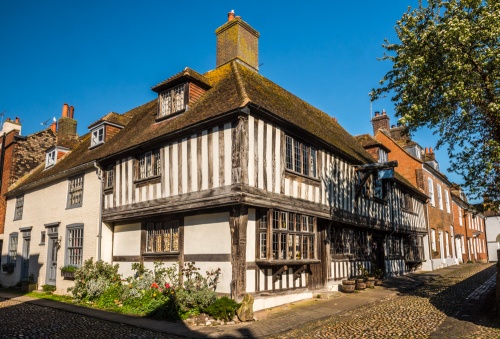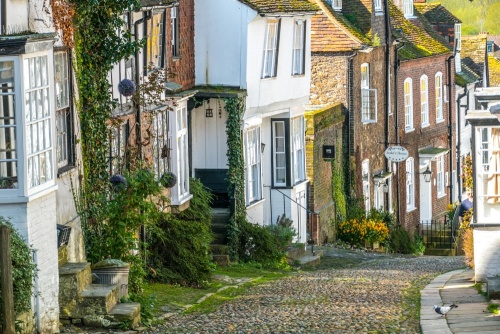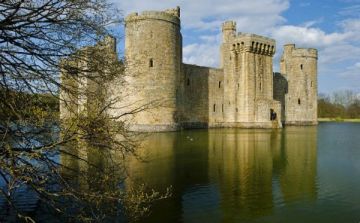
Rye is one of the most attractive and historic towns in the south of England. I use the term 'town' cautiously, for though technically correct, the old historic core of Rye feels more like a quiet village, left behind by the hustle and bustle of modern civilisation.
Rye is situated on a steep hill looking out over flat marshes to the sea, over two miles to the south, and east towards Romney Marsh. You would never know to see it today, but Rye was once one of the busiest ports in Britain, and one of the most important. Wait a minute! If the sea is over two miles distant, how could Rye have been a busy port?
The answer is that the sea once brought heavy sea-going ships to busy docks at the foot of the hill on which Rye is built, but over the passage of centuries the estuary gradually silted up, until navigation was no longer possible, and Rye was left - quite literally - high and dry.
History of Rye
The name 'Rye' comes from a mangling of Saxon words for an island. When you see Rye today it is hard to see why this hilltop town should be termed an island, but appearances can be deceptive. When the sea lapped at the foot of Rye's steep-sided hill it was a busty port, well-placed to benefit from trade along the English Channel.
In 1336 Rye was named an 'Antient Town', affiliated with the Cinque Port. Cinque Ports was a loose confederation of harbour towns created by Edward the Confessor to foster coastal defences.
Gaining Cinque Ports affiliation was a mark of Rye's importance, but even by the 14th century, the writing was on the wall. The most famous event in Rye's long history came in 1377 when the French burned the town to the ground, destroying most of its timber buildings.
One consequence of the raid was that within three years a set of massive stone defences were begun, with thick walls and heavily defended gates. The harbour, always subject to silting, could not be kept clear, and by the 16th century Rye's once busy port had become a forgotten memory as the shore receded further and further from the foot of the hill.

Mermaid Street
Of Rye's many attractive streets perhaps the most picturesque is Mermaid Street, a cobbled lane lined with a mix of medieval timber-framed inns and elegant Georgian houses. Giving its name to the street is one of the oldest buildings in Rye, the Mermaid Inn. This fascinating building has a long and turbulent history, laced with sieges, ghosts, fugitives, and secret passages.
Mermaid Inn
The Mermaid may date back to 1156 when Rye gained membership in the Cinque Ports. Certainly, the foundations and cellars of the Mermaid are of Norman construction. Like most of Rye, the Mermaid was burned by the French in 1377 and only the cellar survived.
It was rebuilt in its current form by 1420, and in the English Reformation it was a refuge for Jesuit priests. You can still see the banned Jesuit symbol “J.H.S.” carved into the oak panelling in Dr Syn’s Loung”.
More famously, the Mermaid was a haunt of the notorious Hawkhurst Gang of smugglers, who would often celebrate at the inn after a successful smuggling exchange on the nearby shore. So confident was the gang that the excisemen would not dare to challenge them that they would lay their loaded pistols in plain view upon the inn tables.

Another famous hostelry in Rye is Jeake's House, a late 17th-century hotel, also on Mermaid Street, built as a storehouse by a successful wool merchant. In the early 20th century Jeake's House was a haunt of such literary figures as Conrad Aiken and poet TS Eliot.
Land Guard Gate
In the medieval period, Rye was fortified by thick town walls, pierced by four large gates. Of these only a single gate still stands; the Land Guard Gate, or North Gate, where you can still see the grooves made for the iron portcullis that once sealed the passage. While the Land Guard Gate defended the north aspect of Rye, the heaviest defences faced the sea. Of these, only a single tower remains; the Ypres Tower, now occupied by part of the Rye Castle Museum.

Ypres Tower
The Ypres Tower was built in the 13th century and once served as a gaol. Its name comes from a 15th-century resident, John of Ypres. It is one of the very few buildings to survive the devastating French raid of 1377. Just in front of Ypres Tower are the Gun Gardens, site of the Tudor gun emplacements that were a major part of Rye's defences.
Rye Castle Museum is divided in two - there are two separate parts of the museum - one located on East Street and the other taking up the interior of Ypres Tower. The museum details the long a colourful history of Rye, with exhibits of local crafts, historical objects (including medieval armour) and models of the village over time.
Editor's Note: Our children loved the museum, and enjoyed dressing up in armour.

Lamb House
One of the most intriguing of Rye's numerous historic buildings is the Georgian-fronted Lamb House, on West Street. Lamb House was built in 1772 and visited by George I. In 1897 the author Henry James made his home here and stayed until his death in 1916.
It is hard to pick only a few of Rye's numerous historic buildings, but one that deserves mention is the Old Hospital, a timber-framed building that dates to the 15th century. The Old Grammar School on High Street is a relative parvenu, erected in 1636 in Dutch style.
St Mary's Church
St Mary's is a striking Norman building dating to the 12th century. Built to a cruciform plan, St Mary's stands almost at the crest of Rye's hill and features stained glass windows by Arts and Crafts pioneer William Morris.
One of the most interesting historical features is a 16th-century clock which boasts an 18-foot long pendulum. The quarter-hours are struck by a pair of gilded cherubs. From the top of the church tower, you can look across a low-lying landscape of fields, marshes, and waterways

Camber Castle
Among the fields is Camber Castle, built by Henry VIII around 1540 as part of his great coastal defence schemes. Camber Castle once stood at the edge of the sea, but, like Rye itself, it was subject to silting of the coastal plain, and now stands a mile from the shore. The castle was abandoned in 1642 and is now in the care of English Heritage. It can only be reached by a mile-long walk over the fields.
About Rye
Address: Rye,
East Sussex,
England
Attraction Type: Town
Location map
OS: TQ920 206
Photo Credit: David Ross and Britain Express
HERITAGE
 We've 'tagged' this attraction information to help you find related historic attractions and learn more about major time periods mentioned.
We've 'tagged' this attraction information to help you find related historic attractions and learn more about major time periods mentioned.
Historic Time Periods:
Find other attractions tagged with:
12th century (Time Period) - 13th century (Time Period) - 14th century (Time Period) - 15th century (Time Period) - 16th century (Time Period) - 17th century (Time Period) - Arts and Crafts (Architecture) - castle (Architecture) - Edward the Confessor (Person) - George I (Person) - Georgian (Time Period) - Henry VIII (Person) - Medieval (Time Period) - Norman (Architecture) - Reformation (Historical Reference) - Saxon (Time Period) - Tudor (Time Period) - William Morris (Person) -
NEARBY HISTORIC ATTRACTIONS
Heritage Rated from 1- 5 (low to exceptional) on historic interest
Rye Art Gallery - 0.1 miles (Museum) ![]()
Rye Castle Museum - 0.2 miles (Museum) ![]()
Lamb House - 0.2 miles (Historic Building) ![]()
Camber Castle - 1.3 miles (Castle) ![]()
Winchelsea Court Hall Museum - 2.2 miles (Museum) ![]()
Winchelsea, St Thomas the Martyr Church - 2.3 miles (Historic Church) ![]()
Blackfriars Barn - 2.3 miles (Historic Building) ![]()
St John's Hospital - 2.6 miles (Historic Building) ![]()



